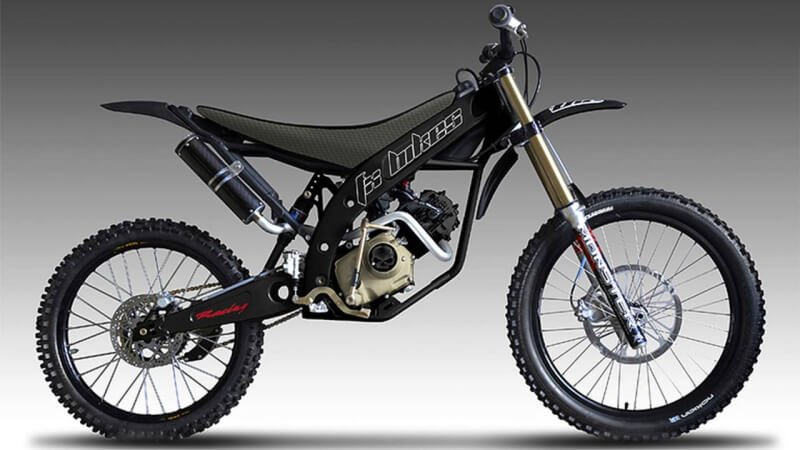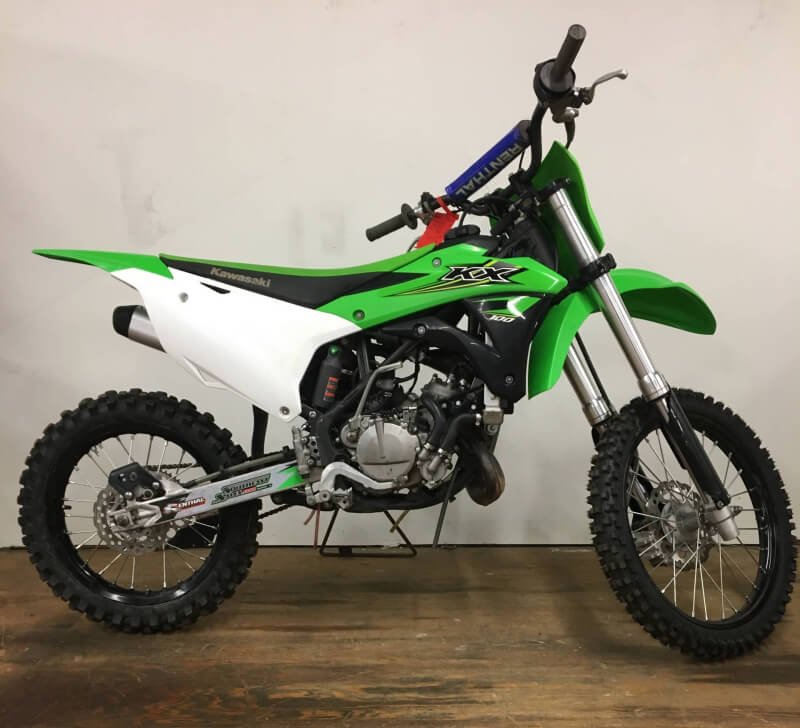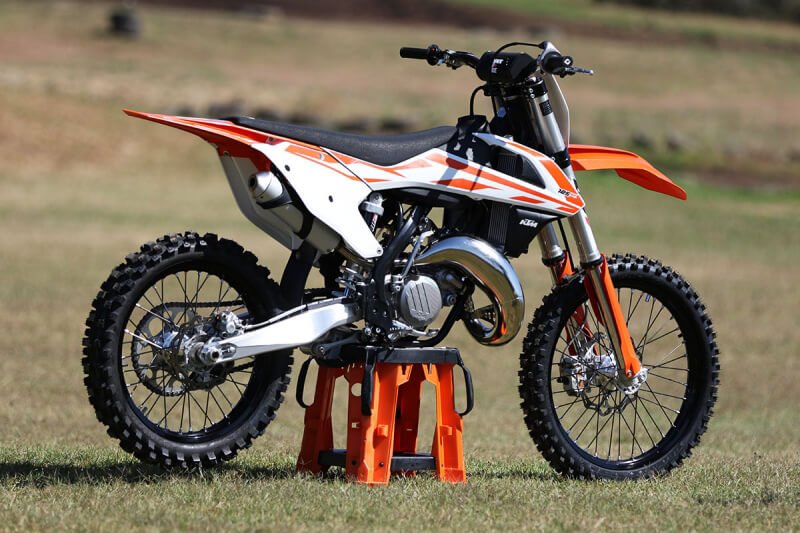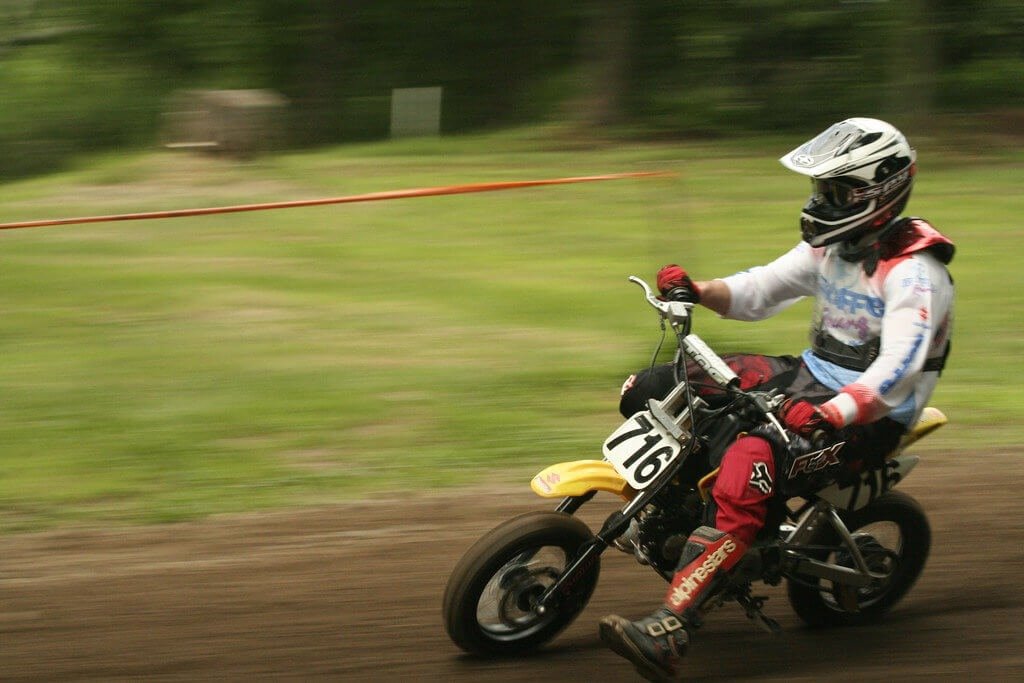Any rider wants the best lightweight dirt bike to gain a competitive edge.
The trouble is that many of them are pricey and aren’t feasible for everyone to ride. Manufacturers have every right to charge more for less, because these bikes offer more speed and better pick-up than their competition.
When you have a group of good racers, often the only thing that makes the difference is the weight of the bike. While there are ways to put your bike on a diet, it helps to start with one of the lightest dirt bikes out right of the box. That’s why we ranked seven top models you might not be aware of.
All told, the bikes on this list are separated by less than 85 pounds. You will notice some of these manufacturers claim dry weight - the weight of a bike without fluids - to help them net these top spots.
We will also go over the difference between dry and wet weight on a dirt bike and 4 Tips to Help Save Weight on your dirt bike. Of course, the biggest tip might be skipping a Big Mac meal here and there, but that one’s liable to get me slapped.
In our list, you will see some light dirt bikes you already knew about, but a few of the things on this list might just surprise you. So buckle in and let’s get down to business with:
7 of the Lightest Dirt Bikes of the Modern Age
1. Mountain Moto FX5 (132 Pounds)
We’re starting with the slimmest of them all, and it’s likely a dirt bike you have never heard of.
The Mountain Moto FX5 is the world’s lightest production dirt bike weighing in at just 132 pounds dry.
It was launched by a New Zealand company with the goal of claiming the title as the world’s lightest dirt bike. FX Bikes wanted to combine motorcycle parts with a mountain bike to come up with the best of both worlds.
Their initial concept weighed in at 125 pounds dry when it was first revealed. The production version ended up slightly heavier, but there’s still nothing to complain about. The added weight went to improve durability plus increase performance. In fact, the only mountain bike part they kept as part of the design was the handlebars.
The FX5 uses the KTM 350 frame, but FX Moto lowered the ground clearance and shaved weight in multiple places. There’s also a choice of engines offered for this bike, from a Daytona-Japan motor to a four-stroke 125cc YX. FX Moto offers manual and automatic gearboxes for this machine.
What’s great about having a dirt bike that only weighs 132 pounds dry is that riders can lift the bike themselves. This helps them to get over obstacles with ease and put the bike in the back of vehicles without much effort.
In short, these bikes can go places heavier bikes will never see.
The company offers three levels: Steel, Gold and Titanium. Prices start at $4,395 for the Steel version and rise to $11,995 for the Titanium. Of course, anyone with the extra money would be a fool to not purchase the top of the line specifications. This lineup offers carbon fiber handlebars, ten frame and seat color options plus a titanium fastener set, and all the bragging rights of sporting the world’s lightest production dirt bike.
Of course, if you lose a race on the world’s lightest dirt bike, you’re going to be running low on excuses.
2. Kawasaki KX100 (170 Pounds)
The Kawasaki KX100 was designed for kids, but we think it’s far more than a youth rider.
In fact, this bike packs plenty of big-bike performance. It has a 34-inch seat height though it weighs just 170 pounds wet making it one of the lightest dirt bikes anywhere. While it would be a great learning tool for the family, we prefer to keep one for ourselves. At $4,599, the kids would have to mow a lot of lawns to acquire this bike anyway.
Don’t let the small size deceive you, the 99cc two-stroke engine offers the same look as the KX counterparts and has no trouble outperforming the competition. In addition, this bike was designed with the same technology as the full-size models. It even features an adjustable handlebar system which puts riders in the best position. Team Green wanted to make sure that this bike was a natural stepping stone to preparing the next generation of racers from the 85cc to a full-size bike.
The chassis is also like the rest of the KX lineup. It features 36mm inverted front forks and 20-way adjustable compression damping. It also offers 10.8 inches of travel in the front. In the back, the KX100 includes the Uni-Trak linkage for optimal handling. It also features a high-performance shock with 24-way compression plus 21-way rebound damping adjustment. This offers the back the same 10.8 inches of travel as the front.
So, whether you are a teenage rider or a full-grown adult, you can have a lot of fun on a KX100.
3. Honda CRF150R (187 Pounds)
This isn’t your typical off-road bike with a low seat height; it’s much more than that.
The Honda CRF150R contains a 149cc single-cylinder engine and only weighs 187 pounds wet. Measurements include a 50.6-inch wheelbase, 1.1-gallon fuel tank and 34.1-inch seat height. Brand new, you are looking at $5,299 for this machine.
That isn’t bad considering what you get for your money.
This serious competition bike features the Unicam engine to give young or beginner riders all the performance needed to keep up with the competition. In 2018, Honda even updated the graphics on the bike for a more aggressive look. If you want something with bigger wheels, a longer swingarm and higher seat, you could opt for the CRF150R Expert instead.
As far as the suspension is concerned, you are looking at a 37mm inverted fork and Pro-Link rear linkage system. Both the front and rear settings deliver optimal bump-absorption for a smoother ride. The high-tensile steel frame remains lightweight but also works with the large-diameter tubing to provide superior turning performance plus flawless straight-line tracking.
Honda includes lightweight body components to keep the bike nimble. This consists of the side covers, radiator shroud, rear fender, fuel tank, seat base, front number plate and front fender all made of plastic. This design helps it become one of the lightest dirt bikes around, a true competitor to any other.
4. Husqvarna TC125 (193 Pounds)
At first glance, you think the Husqvarna TC125 is small in capacity, and you wouldn’t be wrong. But, it makes up for it with the capability it offers.
This 40 hp bike had some recent refinements to the powerplant plus they added a new six-speed PANKL gearbox to provide this bike with more torque and power than anything else in its class.
What’s left is a bike made from premium materials that is a contender against all other seasoned racers. The innovative power valve design is one thing that propels it to success, along with the 54mm bore size. In addition, the lateral and main exhaust ports feature a machined finish for more accurate airflow and timing. This leads to 2-stroke performance unlike anything you are accustomed to.
The company also constructed the crankshaft to be as light as it could be while balancing it perfectly which reduces vibration. Then, they position it precisely so the rotational mass doesn’t affect the handling.
Husqvarna also utilizes high-pressure die-cast production to keep the weight down. They added a reinforced kickstart intermediate gear to increase the starting reliability. Finally, there’s an iconic emblem placed on the crankcase on top of the bronze finish to offer a salute to legends of previous years.
All that on a bike which weighs just 193 pounds wet, solidly one of the lightest dirt bikes of the modern age.
5. KTM 125 SX (195 Pounds)
The Austrian-built KTM 125 SX is meant for the off-road enthusiast with orange blood in their veins.
It’s been around the world and doesn’t hold anything back, other than extra weight. Over the past couple of decades, this company has been one of the top to beat. You’ll find it racing in the desert to the rocks and every other terrain you can imagine.
It is bikes, just like this, that continue to put KTM on podiums. You’ve seen them win the Baja 1000, the Dakar Rally and more races than we can count.
The latest engine in the 125 SX is the most powerful and competitive in its class. This durable motor was created to provide more power across the rev range than ever before. Aside from the ease of rideability and superior performance, this bike offers some of the fastest lap times for seasoned riders thanks to its dry weight of just 195 pounds.
The high-tech steel frame used on this bike has been specially optimized to offer superior rider feedback. All of the updated flex characteristics of this dirt bike soak up the hits while providing high-speed stability and unparalleled agility. At all times, the rider is 100-percent in charge of what’s happening, characteristic of one of the lightest dirt bikes of the modern age.
What makes this bike truly unique is the number of mods that are now available. Many aftermarket companies have jumped on the bandwagon to make sure your 125 SX is truly custom. Keep in mind that adding these might change the weight in the long run, so always choose your modifications carefully if weight is your main concern.
6. Yamaha YZ125 (208 Pounds)
If you don’t know about the YZ125, then it’s safe to assume you have been living in a cave.
It’s been in showrooms since 1974 and many motocrossers in every decade rode one in competition. Of course, it had a lot of companies looking to take it down during that time.
In the mid-2000s, we saw an end to the competition because of the newer four-stroke revolution. 250cc four-stroke bikes quickly exceeded the power of the YZ125 and many other two-strokes started to disappear. Kawasaki, Suzuki and Honda even took their comparable models out of their lineup, leaving the YZ125 to be the top two-stroke 125 in the market.
A war of attrition, it turns out.
Over these years, Yamaha never gave up. They even gave a new frame to the YZ125 in 2005, an updated motor in 2006 plus brand-new bodywork in 2015. Yamaha also added a KYB suspension and some small updates to the motor’s internal parts to keep with the times.
Despite the age, the YZ125 remains relevant today. It has modern components such as Nissin brakes, Pro Taper fat bars, Dunlop Geomax MX52 tires, Excel rims and wave rotors to keep it contemporary. This bike not only deserves to be on the lightest dirt bike list, weighing in at just 208 pounds wet, but it should be honored as a staple of racing history.
It’s nimble and effortless to rail into a corner. You can push this dirt bike pretty hard and not face a problem. And while it may not be around forever, you can still get a new model of this legendary machine for $6,499 today.
7. Beta 200 RR 2-Stroke (215 Pounds)
We end our list of the lightest dirt bikes with another relatively obscure model, at least in some circles: the Beta 200 RR 2-Stroke at 215 pounds dry.
The 200 RR offers all the handling characteristics of the Beta 125 but with a big boost in torque power. It also provides oil injection and electric start. Both the engine and chassis setup come from the smaller 125, and even the clutch and gearbox are identical to the 125, but the larger 200 appeals to a broader audience.
Tackling any terrain is a breeze on the back of this bike. Whether you like to drive up steep inclines or blaze a path through the woods, this bike doesn’t disappoint. While it won’t have the power of the 300 or 390 RR, it makes up for all of that with the ultra light weight.
It’s still light enough to manhandle, but continues to offer plenty of grip and power so you enjoy the thrill. It’s the bike you always hoped for out of a 125. That’s due in part to the exceptional chassis design and new ZF suspension. Anyone who takes a ride on it instantly falls in love, and for a good reason.
What’s the Difference Between Dry Weight, Wet Weight, and GWVR?
Now when you see the lightest dirt bikes advertised, you will know the facts.
The weight of a vehicle can be expressed in various ways. When it comes to dirt bikes or motorcycles, you are looking at three different methods to represent the weight: dry weight, wet weight and gross vehicle weight rating, otherwise known as GVWR.
The goal of a manufacturer is to make the bike sound as light as possible. Let’s face it; lighter dirt bikes handle and perform better than the heavier ones do, even if that number is only true in someone’s mind.
The GVWR relates to the maximum total weight of the bike and all consumables. GWVR includes the vehicle, passengers, and cargo. It’s standardized and commonly understood. It’s also defined by law and regulated by the US Department of Transportation.
On the other hand, wet and dry weights are not standardized measurements. Both of them apply without the weight of a rider, passenger or cargo. In addition, they might include a variety of lubricants, fuels and possibly the battery. Still, many bikes will use these numbers to compare specifications.
Dry weight
A vehicle’s dry weight is the weight of the vehicle without fuel. When calculating dry weight, manufacturers often exclude brake fluid, coolant, and engine oil as well. There is no industry standard for testing dry weight.
Dry weight measurements are often given to avoid the weight changes that occur while a vehicle consumes its fluids. This number is useful for comparing two bike models to one another that have different fuel capacities.
But it’s not always that easy
This makes the comparison between two bikes difficult because the weights given don’t correspond with a running bike. Some choose to also exclude the bike’s battery to further lower the number, complicating things even more.
That leaves a lot of room for inconsistency from the manufacturer and media outlets. That’s because each has its own method of testing for dry weight. The higher the capacity the bike is; the bigger the weight difference will be between the dry and wet numbers since you have to factor in the added weight of fuel and fluids.
You might also find that a bike ships without any hydraulic fluid, so this might not be included in the dry weight either. On occasion, some motorcycles ship with hydraulic fluid in the front brake and reservoir, but there’s also the chance of needing it in the rear brake and tank plus the clutch and reservoir as well, all in an effort to sound like the thinnest guy at the track meet.
Wet weight
A vehicle’s wet weight (or curb weight) includes the fuel, coolant, brake fluid, and any other fluid necessary for the vehicle to operate. Wet weight corresponds to a running and driving vehicle parked at the curb, hence the name “curb weight.”
Starting in 2009, many dirt bike manufacturers began to publish wet weight numbers. This includes BMW and the Big Four Japanese companies. Since then, other manufacturers have followed suits to comply with EC directives which state that values should indicate running order.
But it’s not always that easy
Honda refers to this weight as the curb weight and states their bike specifications state that the bike is ready to ride. Some other companies figure the wet weight when the fuel tank is less than full, but it’s still considered ready to ride. Others will clearly exclude the fuel altogether.
You still get the odd company that pulls a dry weight number like Mountain Moto did in this countdown. They usually don’t advertise the “dry” part as boldly as they do the “weight” part, so you have to watch out.
Technically speaking, the final wet weight of a bike or motorcycle is supposed to include the battery, fuel, coolant, brake fluid and engine oil. Again, there’s no way of measuring these figures accurately so inconsistencies are often found between the manufacturer’s specs and media outlet testing.
When a leading site like Cycle World tests a motorcycle, they also publish the wet weight including all the consumables on board at the time of testing. However, they also only include a half tank of fuel, so again, take this as you will.
Now when you see the lightest dirt bikes advertised, you will know the whole story.
4 Best Ways to Save Weight on a Dirt Bike
Because lower weight equals added performance, many dirt bike riders take to the Internet to find ways of dropping the bike’s weight. Before you start making modifications to your ride, it’s important to consider that having a heavier bike might offer more control. This is especially true if you are a new rider.
Depending on what your height is and how skilled you are, you might actually prefer a heavier bike. It might make you feel more secure and help you to stick to the track better. With that said, carrying extra weight does slow the bike down.
If you do a lot of Motocross racing with steep hills involved, you’ll notice it better than anyone. Just picture two cars traveling through the mountains. A small, light vehicle can bypass those towing a trailer or filled with passengers. It’s the same concept with dirt bikes.
If you want to find ways to lower the weight of a dirt bike, we have a few tips to get you started. Aside from choosing one of the lightest dirt bikes to begin with, you can also try these steps.
Tip #1 – Go to the bathroom
Before you laugh, this is a serious way to reduce weight. The nice part about this method is that it doesn’t cost you a penny. The human bladder can hold up to 1 liter of urine. Considering that’s about ¼ of a gallon, you are looking at a couple of pounds of weight you simply don’t need on your dirt bike.
With the same concept in mind, be mindful of what you eat before race day. The stomach holds a lot of liquid and fluid, all of which convert to more pounds on your bike.
Just be careful giving this advice to your partner.
Tip #2 – Drain your tank
Professional racers only carry the amount of fuel they absolutely need to finish a race.
If you are competing, do you need a full tank of fuel? Probably not. Many motocross bikes carry about two gallons of gasoline, which equals roughly 12 pounds. Considering amateur racing typically only consists of a maximum five laps, you really aren’t going to need that full tank.
Instead, do some practice runs and figure out how much fuel you will use. Then, reduce your fuel level accordingly. You shouldn’t need much more than a gallon, which saves you about another six pounds.
Tip #3 – Stay in shape
Those in the know call it the “light rider mod” for good reason.
The biggest adjustment to the weight of the bike is the rider. If you are carrying an extra 20 pounds, that is going to affect your racing ability. The veteran you are racing against who doesn’t drink extra beer and eat bags of chips is going to perform better any day of the week, no matter how much you practice. That’s because his bike will be lighter by way of his body being lighter, allowing him to go faster.
Furthermore, losing weight is an inexpensive way to improve your performance. You don’t have to invest money in parts; all you have to do is take care of yourself. By the way, this comes with added benefits like feeling better and living longer too. Just saying.
Tip #4 – Consider swapping parts
This option is always available and one that many competitive riders will move on to. There are tons of parts you can swap out that will lower your bike’s weight. The question comes down to how much money you have to spend on these parts.
Look for lightweight materials such as aluminum or titanium. There’s really no end to the components you can replace from the wheels, exhaust, brake systems, mudguards, sprockets and hardware. If this is the avenue you want to take, start with one part at a time. Make sure you make any adjustments needed once you swap out the parts and then take the bike for a ride. If it changes the handling at all, you might need to compensate with your technique.
If you find yourself getting down to titanium bolt kits and carbon fiber heel guards, you might be taking it too seriously. But we’ve seen it done and we can’t say it doesn’t help.
Perform on the lightest dirt bike
Far and away, the best way to get the lightest dirt bike on the market is to buy it already made. But even if you go with a cheap bike for your adventures, you can still follow the steps outlined above to lessen the weight and maximize performance. The sky’s the limit.
























Dirt biking remains a vibrant and evolving culture as we head into 2025. Gas-powered bikes continue to see steady, incremental improvements, while electric dirt bikes are rapidly advancing with lighter components, longer battery life, and impressive torque. Legislative efforts like House Resolution 906 aim to empower riders with the right to repair their own vehicles, fostering independence within the community. Despite restrictive state regulations, dirt biking culture thrives, with growing sales and creative solutions like Montana LLC registration ensuring riders can hit the trails legally. The future of dirt biking is a blend of tradition, innovation, and resilience.